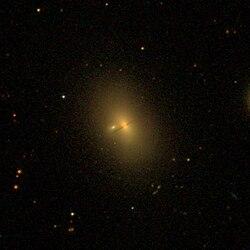| NGC 810 | |
|---|---|
 SDSS image of NGC 810 | |
| Observation data (J2000 epoch) | |
| Constellation | Cetus |
| Right ascension | 02h 05m 28.563s[1] |
| Declination | +13° 15′ 05.88″[1] |
| Redshift | 0.02592[2] |
| Heliocentric radial velocity | 7670 km/s[2] |
| Distance | 355.7 ± 25.0 Mly (109.06 ± 7.66 Mpc)[3] |
| Apparent magnitude (B) | 15.4[2] |
| Characteristics | |
| Type | E5[4] |
| Other designations | |
| UGC 1583, MCG +02-06-026, PGC 7965[2] | |
NGC 810 is an unbarred[4] elliptical galaxy located in the constellation Cetus, approximately 360 million light-years from the Milky Way.[3] It was discovered by the French astronomer Édouard Stephan in 1871.[5]
NGC 810 is currently in a merger event.[4] It is interacting with the galaxy SDSS J020529.28+131503.5.[6]
See also
[edit]References
[edit]- ^ a b Skrutskie, Michael F.; Cutri, Roc M.; Stiening, Rae; Weinberg, Martin D.; Schneider, Stephen E.; Carpenter, John M.; Beichman, Charles A.; Capps, Richard W.; Chester, Thomas; Elias, Jonathan H.; Huchra, John P.; Liebert, James W.; Lonsdale, Carol J.; Monet, David G.; Price, Stephan; Seitzer, Patrick; Jarrett, Thomas H.; Kirkpatrick, J. Davy; Gizis, John E.; Howard, Elizabeth V.; Evans, Tracey E.; Fowler, John W.; Fullmer, Linda; Hurt, Robert L.; Light, Robert M.; Kopan, Eugene L.; Marsh, Kenneth A.; McCallon, Howard L.; Tam, Robert; Van Dyk, Schuyler D.; Wheelock, Sherry L. (1 February 2006). "The Two Micron All Sky Survey (2MASS)". The Astronomical Journal. 131 (2): 1163–1183. Bibcode:2006AJ....131.1163S. doi:10.1086/498708. ISSN 0004-6256. S2CID 18913331.
- ^ a b c d "NGC 810". SIMBAD. Centre de données astronomiques de Strasbourg. Retrieved 2020-05-24.
- ^ a b "Results for object NGC 0810 (NGC 810)". NASA/IPAC Extragalactic Database. California Institute of Technology. Retrieved 2020-05-24.
- ^ a b c García-Benito, R.; Zibetti, S.; Sánchez, S. F.; Husemann, B.; De Amorim, A. L.; Castillo-Morales, A.; Cid Fernandes, R.; Ellis, S. C.; Falcón-Barroso, J.; Galbany, L.; Gil De Paz, A.; González Delgado, R. M.; Lacerda, E. A. D.; López-Fernandez, R.; De Lorenzo-Cáceres, A.; Lyubenova, M.; Marino, R. A.; Mast, D.; Mendoza, M. A.; Pérez, E.; Vale Asari, N.; Aguerri, J. A. L.; Ascasibar, Y.; Bekeraitė, S.; Bland-Hawthorn, J.; Barrera-Ballesteros, J. K.; Bomans, D. J.; Cano-Díaz, M.; Catalán-Torrecilla, C.; et al. (2015). "CALIFA, the Calar Alto Legacy Integral Field Area survey. III. Second public data release". Astronomy and Astrophysics. 576: A135. arXiv:1409.8302. Bibcode:2015A&A...576A.135G. doi:10.1051/0004-6361/201425080. S2CID 118636619.
- ^ Ford, Dominic. "The galaxy NGC 810 - In-The-Sky.org". in-the-sky.org. Retrieved 2020-02-28.
- ^ "SDSS J020529.28+131503.5". SIMBAD. Centre de données astronomiques de Strasbourg. Retrieved 2020-05-24.
Well, that’s interesting to know that Psilotum nudum are known as whisk ferns. Psilotum nudum is the commoner species of the two. While the P. flaccidum is a rare species and is found in the tropical islands. Both the species are usually epiphytic in habit and grow upon tree ferns. These species may also be terrestrial and grow in humus or in the crevices of the rocks.
View the detailed Guide of Psilotum nudum: Detailed Study Of Psilotum Nudum (Whisk Fern), Classification, Anatomy, Reproduction